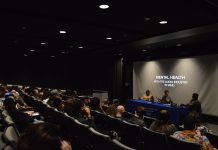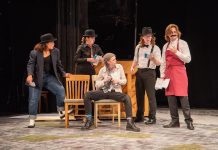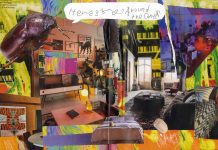A student-run exhibit titled “Back to Our Roots” sets a goal for students to reconcile with their past.
Webster’s first-ever student-run exhibit entitled “Back to Our Roots” hopes to address some topics like existential crises, death, and coming out. “Back to Our Roots” is an exhibition that focuses on diversity, inclusion and smashing hierarchies. The art show opens on Feb. 21 at 6 pm. The exhibit is located at Arcade Contemporary Art Projects, a space on Webster University’s Gateway Campus, 812 Olive St., St. Louis.
Co-curators Sophia Coon, Lillian Gardner, Sarah Houseman and Danielle Sartori established their no hierarchies rule early and asked a blind jury to select the pieces featured in their exhibit. There will not be a central piece promoted. Instead, they opted to allow all of the pieces to be displayed at the same level of importance.

The exhibit aims to connect Webster students to one another despite the segregation that occurs between the different departments Coon, a senior studio art major, said.
“We really wanted to use the diversity angle to bring the different schools and disciplines together in one space for one event,” Coon said.
The show features work from at least nine majors: advertising and marketing communications; psychology; graphic design; film, television and video production; photography, and audio production. Each artist develops the theme of going back to their roots in their own specific way.
For Raven Ritrovato, that means revisiting how her brother Zachary’s death affected her.
“The whole meaning for this exhibition is something personal that brought you to who you are today and I blame a lot of my personality on my brother,” Ritrovato said. “He made me be the type of person that wants to smile every day.”
Ritrovato, a junior graphic design major, brings her brother with her in her art. Typically, her pieces are more joyful but this work is different. Her featured zine, described as a do-it-yourself magazine, is a more emotional piece full of longing and sadness. Focused on Blink-182’s song I Miss You, the zine is full of Ritrovato’s own illustrations and family photographs that correlate with the lyrics.
“Even a small project could be something that means so much to someone,” Ritrovato said.
Carolyn Hasenfratz is a graduate student in the advertising and marketing program. Hasenfratz focuses mainly on an art form called faux postage. This method allows artists to make up their own stamps as a form of commentary. Her piece also focuses on the death of a loved one. Her friend Mark, who died in 2018, often collaborated with Hasenfratz on her faux postage pieces.
“Whether we were actively collaborating or not, I knew his influence on my work was felt,” Hasenfratz said. “His influence will continue to be felt and warmly remembered by me as long as I am alive, in art and in life.”
Candace Mothersbaugh’s piece was influenced by the way she walks through the world as a trans woman. Titled “Trans Panic,” the work is a collage of her face and how she picks apart herself in order to control how she is perceived. Her work includes a layer of text over the collage on how people perceive trans people.
“The piece doesn’t really offer any solution to this problematic way of thinking but I think it provides a jumping-off point about how trans people are being made to feel,” Mothersbaugh said. “I think that’s where Back to Roots comes in, the show is all about addressing our experiences and how they shaped us into who we are.”

Other pieces include Philip Irving’s film Love Thy Neighbor about an anxious, young black woman coming out to her father, Taylor Kolkmeyer’s three poems “Happy for a Hot Minute,” “Crowded” and “(Imagine) brought to you by ProsePro Posthumous Publisher®”, and 18 other works.
Back to Our Roots will sell merchandise at the opening. All profits will be donated to the local organization Bread & Roses Missouri which aims to support art that deals with social and economic justice. The exhibition will run until March 20.
Co-curator Sartori hopes the exhibit encourages healing and growth within the Webster Community.
“Back to Our Roots hopes to bring Webster together while also encouraging students to create art based on the question ‘How they get to be who they are today?’” Sartori said. “We are each a sum of our experiences and we have a choice of how to react to them.”



